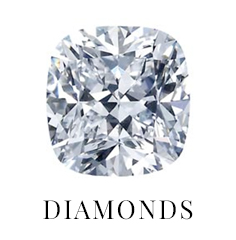Diamonds

When you make a major purchase, you want to be sure you are getting value for your money. When you're thinking about buying a new car, you can look at consumer magazines, you can ask your friends, and you will surely want to listen to what your trusted mechanic has to say. But, in the end, it's up to you. How do you think the car handles? How do you like the way it looks? Does it meet your needs? And how will it affect your budget?
Diamond Education
A diamond deserves the same thoughtful consideration. After all, long after a car has served its useful life, your diamond will continue to give you pleasure and satisfaction.
The American Gem Society (AGS) has prepared this information to help you understand the things you need to consider when you make this very important decision.
Why Should I Shop At AGS Member Stores?
American Gem Society membership is your guarantee that you are doing business with jewelry professionals: a staff and store that is committed to on-going gemological training, customer service of the highest caliber, and, above all, integrity.
Since 1934, the American Gem Society has been promoting the highest professional standards of ethics, education, and service in the jewelry industry. AGS members are tested and retested annually to make sure that the working professionals you meet in AGS member stores can give you the best information possible about your diamond purchase.
AGS members are respected leaders in the jewelry industry, and long-term members of your community. Your satisfaction is important to them because they know that, to build trust and confidence, they must provide you with the very best service and information available. Their success is enhanced by your satisfaction.
When you shop for diamond jewelry or for a very special diamond, the first thing to look for is the firm's membership in the American Gem Society.
What Is The American Gem Society Grading System?
Diamond grading is a highly specialized field, but it doesn't have to be mysterious. Many consumers can distinguish between diamonds that are at extreme ends of the scale. True, when the calls are closer, it takes a trained professional grader to make the distinction.
Yet these distinctions can represent considerable differences in cost to you, the consumer. AGS members know that customers want to understand all the factors that influence the value of the jewelry they buy. For this reason, the American Gem Society has developed the AGS Diamond Grading System.
The AGS system grades three value factors: cut, color, and clarity. Each factor is evaluated on its own 0 to 10 scale. The scale begins at 0, the highest grade, and goes down to 10, the lowest. The three factors are expressed separately along with the carat weight of the stone for the final AGS Grade.
For example, the AGS Grade for a 1.25 carat diamond with a cut grade of 3, a color grade of 4, and a clarity grade of 2 would be expressed 3/4/2-1.25. To avoid confusion, the AGS Diamond Grading System always expresses characteristics in the same order: cut, color, clarity, and, finally, carat weight.
When you make a major purchase, you want to make clear, informed choices. The AGS Grading System helps you to define differences and gives you the information you need to make decisions.
If a diamond you are considering has a clarity grade of 2, then it's easy to see where it fits on the scale. Specifically, you know that it is between 1 and 3 on the clarity grading scale, but you can also generalize by seeing that the stone is on the higher end of the grading scale for clarity. From there, and considering the grades on the other value factors, you can make an informed decision when you buy a diamond.
The AGS Grading System is easy to understand, yet fully capable of making - and explaining - the important distinctions that affect the value of the diamond you are considering.
What Is Cut and How Is It Graded?
Cut is the only value factor that can be controlled by human hands. The qualities of a diamond in the rough can only be brought out by the work of a skilled artist. Before you see a sparkling diamond under the lights in your local jewelry store, it has already been shaped to stringent specifications by a skilled artisan, and given its beautiful polish.
The goal of the expert diamond cutter is to fashion a diamond that produces the most satisfying return of light to the eye within a pleasing symmetrical shape. All the while, the cutter is balancing the goal of attaining maximum brilliance and symmetry against the inevitable loss of weight necessitated by the very process of cutting.
Symmetry plays an important role in how light is returned to the eye, but it is also a characteristic to be considered on its own merits. Think of it as how closely the right side of the stone matches the left. Imagine placing a mirror on an imaginary line that runs through the center of the stone. The image in the mirror would correspond exactly to the half of the stone it reflects. In a perfectly symmetrical stone, the left and right side of the stone would be like mirror images of each other.
In addition to proportion and symmetry, how the diamond is polished affects the final cut grade, too. A well-polished diamond produces sharp sparkle and undistorted brilliance and fire. By contrast, even a well proportioned, symmetrical diamond can look dull or fuzzy if the polish is poor.
The most exquisitely cut round brilliant diamond, called the "ideal cut',' earns a 0 cut grade on the AGS Diamond Grading Scale of 0-10. The 0 cut grade is reserved for those round brilliant diamonds which conform to the cut dimensions calculated to produce maximum brilliance with a high degree of "fire" for the most beautiful return of light to the eye. It is a rare diamond that adheres absolutely to these rigorous standards. But the grades between 0 and 10 represent a broad spectrum of cutting characteristics for you to consider.
How Is Color Graded?
If you've ever tried to match the colors on the rack in a store with something in your closet at home, you know how deceptive color can be. Distinguishing color is not as easy as it seems at first glance. With diamonds, even small differences in color can make a big difference.
A colorless diamond is graced with that glorious display of light and prismatic colors for which diamonds are so highly prized. The presence of color then goes from barely discernable near colorless to light yellow or brown. Beyond a certain point, or with other colors such as green or red, a diamond is considered a fancy color.
Unless a diamond is a fancy color, the AGS Color Grading System places it on a 0 to 10 scale, to show the range from the rarer colorless diamonds to those diamonds with varying tinges of yellow or brown.
To find an accurate color grade, an AGS member jeweler compares each stone to a set of Masterstones which have been graded according to AGS standards. It is part of an AGS member store's commitment to maintain a minimum of three, and frequently five, masterstones specifically for grading purposes.
Masterstones are diamonds, not cubic zirconia (CZ). Ask any jeweler to show you the Masterstone Set by which their diamonds are color graded. Maybe you won't be able to discern the fine color differentiations between the stones, but you will certainly get a glimpse of that store's commitment to professionalism. If they take the trouble and bear the expense of maintaining a set of Masterstones, you get a sense of their dedication.
What Is Clarity and How Is It Graded?
Clarity characteristics are divided into two main groups: inclusions and blemishes. Inclusions are inside the stone; blemishes are on the surface.
There are many kinds of inclusions. Some are quite well-known and may be familiar to you: feathers, clouds, cavities, and the presence of crystals within the diamond.
Blemishes include characteristics such as abrasions, nicks, pits, scratches, and others as well. Since blemishes affect the polish, they are often counted under cut rather than clarity. (If so, they are not counted twice.)
Two tools are used for judging a diamond's clarity: magnification and the human eye. All American Gem Society grades are determined by a professional using a special stereoscopic zoom microscope.
It will be interesting and informative for you to ask your jeweler to show you your diamond under the gem microscope. With some helpful pointers about what to look for, and perhaps a plot map, you'll see the wonders that are hidden within your diamond.
If magnification to the tenth power under a gem microscope reveals nothing-no small feather, no tiny crystal-the diamond earns a Clarity Grade of 0, the grade for the most exquisitely clear diamonds.
If magnification reveals that light returning to your eye may be affected by one or more inclusions, the professional AGS jeweler determines the appropriate grade along the continuum of 0 to 10.
In addition to the microscope, the grader's skilled eye is another tool for judging clarity. If your jeweler can see a clarity characteristic without magnification, you can too. The presence of such a characteristic could cause the grade of the diamond to drop on down below the middle of the scale.
Remember, most diamonds have some inclusions. This doesn't mean that a diamond with an inclusion isn't a quality diamond. It does show that your AGS jeweler wants you to have all the facts necessary for you to make an informed decision.
What Should I Know About Carat Weight?
The cut, color, and clarity grades each have an effect on the value of a diamond, but the weight of the diamond has a significant effect on its value, too. The discerning buyer considers all four factors.
You're probably familiar with the term carat, the unit of measurement used to indicate the weight of gemstones. (This should not be confused with karat, the term jewelers use when stating the relative fineness of gold.)
You want to be sure your jeweler is clear about the terms that are used in reference to the weight of a diamond. One carat is equal to 1/5 of a gram. For diamonds less than one carat, weights can be expressed in terms of halves and quarters (as long as they are at least half or a quarter). For more precision, the carat can be divided into 100 points. Thus, a 10 point diamond is 1/10 of a carat.
Since small variations in weight can make big differences in price, you want to be sure that your diamond has been weighed in a precise and repeatable manner. AGS member jewelers weigh unmounted diamonds on an electronic scale capable of weighing as accurately as .002 (two one-thousandths) of a carat. No jeweler should be reluctant to show you how the weight of the stone you are looking at was arrived at.
The most important thing to know about weight is that weight isn't everything. You may come into your local jewelry store with a half carat or one carat stone in mind. That's fine. But you may be faced with a choice between a one carat stone of lesser value than a 90 point stone with higher grades for cut, color, and clarity. Sometimes less is more, even in the world of diamonds. Be flexible-you may get a more pleasing stone.
Of course, a well-cut, high grade, one carat diamond will certainly be more valuable than a similarly cut high grade 90 point stone. And, because of its rarity, a two carat well-cut highly graded diamond will be worth much more than twice what a one carat stone would cost.
What About A Certificate?
When you are shopping for a diamond, you may hear that a particular diamond is "certified" This usually refers to a quality analysis report issued by the Gemological Institute of America's Gem Trade Laboratory (GTL).
The Gemological Institute of America (GIA) is well respected in the jewelry industry. The Institute provides much of the gemological training for jewelers, including most members of the American Gem Society.
But GIA does not "certify" diamonds. GTL quality analysis reports reflect some of the factors which help to determine how a diamond is valued. A color grade, a clarity grade, and a precise weight are each stated on the report. There is, however, no cut grade.
As you look for assurances, and you have every right to expect some assurance when you make a major purchase, your best guarantee is the American Gem Society member store where you shop for your diamond AGS diamond graders are trained in the use of the GIA diamond grading scale and can use that scale appropriately should you want to make comparisons. And AGS members stand behind the value statement they issue regarding each and every diamond they sell.
In the end, remember that AGS member stores are accountable to you, the customer. You can rely on the AGS grades and weights that establish the value of the diamond you are considering. You don't need a "certificate".







